Japanese-brand cars have gone from a non-presence (before the ’70s) to a small presence (in the ’70s) to a major presence (by the ’80s). They now sell more cars than GM and Ford – which only sell a small handful of specialty (and luxury) cars.
But when it comes to trucks, it’s still 1970 for the Big Three. There are only two half-ton trucks that aren’t made by one of the three – and one of those (the Nissan Titan) may not be made for very much longer.
There’s a rumor going around that Nissan will stop making the Titan pickup sometime after 2023. If that turns out to true, it would leave the Toyota Tundra as the only half-ton truck on the market not made by one of the Big Three.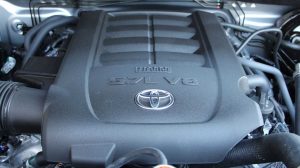
It is also the only half-ton truck that no longer even offers a V8 engine – which until this year was standard in the Tundra.
In its place, a Camry-sized 3.5 liter V6 – turbo-goosed (and interccooled, twice) to develop about the same horsepower and substantially more torque than the V8 – while using a little less gas.
But will it prove to be as Camry-reliable in this half-ton truck, which weighs close to as much as two Camrys – and which is rated to be capable of pulling the weight of three of them down the road?
The Tundra is Toyota’s half-ton (1500 series) truck, similar in general layout to others in the class such as the Ford F-150, Chevy Silverado and Ram 1500. It differs from them in being the only new half-ton truck that does not even offer V8 power. However, it comes standard with a very powerful twin-turbo V6 that makes much more horsepower than the V6s that are standard in the F150, Silverado and Ram – and about the same power as the V8s that are available in the F-150, Silverado and Ram (and standard in the Titan).
The Tundra is also available with an even-more-powerful version of the twice-turbo’d V6 that makes more horsepower (and much more torque) than the most powerful V8s available in the F-150, Silverado, Ram and Titan.
Prices start at $35,950 for the base SR trim in double cab (two full-size front, two smaller size rear doors) with 2WD and a 6.5 foot bed. With the optional 8.1 foot bed, the price goes up to $36,280. Adding 4WD increases that to $38,950 (with the 6.5 foot bed) and $39,280 with the 8.1 foot bed.
The DoubleCab Tundra is also available in SR5 and Limited trims, with the same two bed options for the SR5 (Limited trims come only with the 6.5 foot bed) and either 2WD or (optionally) 4WD.
CrewMax (crew cab) Tundras have four full-size doors – and are available in Platinum, 1794, Toyota Racing Development (TRD) and Capstone trims. The TRD and Capstone trims get the upgraded version of the twin-turbo V6, which is paired with a mild-hybrid set-up to produce 437 horsepower and 583 ft.-lbs. of torque.
These trims are not available with the 8.1 foot bed, due to the length of the cab. They are also available with a shorter (5.5 foot) bed, in addition to the 6.5 foot bed.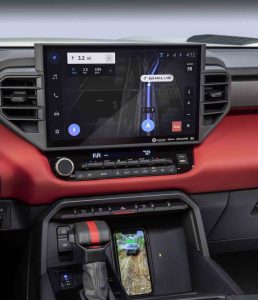
A top-of-the-line Capstone with the up-rated V6, 4WD, 22 inch wheels and power-deploying running boards stickers for $74,230.
What’s New for 2022
The Tundra gets its first (and most radical, ever) makeover since 2007. In addition to the new engine, there is also a new all-independent (coil spring rear rather than leaf spring) suspension, which allows for individual wheel articulation and a smoother ride on uneven surfaces.
What’s Good
Standard V6 makes V8 power – and it’s standard.
Available hybrid version of the V6 makes more-than-V8 power.
Immense towing capacity (up to 12,000 lbs.)
What’s Not So Good
Fewer cab/bed configurations offered than Big Three offer.
Strongest version of the V6 restricted to most expensive trims and CrewMax configuration.
Will the twin-turbo V6 be as durable, long-haul, as the V8 proved itself to be?
Unlike all but one of the other trucks in this class – that one being Nissan’s Titan – the Tundra comes with just one engine, a twin-turbocharged version of Toyota’s 3.5 liter V6. It comes in two versions – just the V6, making 389 horsepower and 479 ft.-lbs. of torque – or the V6, enhanced by a mild-hybrid system that bumps that up to 437 horsepower and 583 ft.-lbs. of torque.
This engine replaces the previously standard 5.7 liter V8 that made 381 horsepower and 401 ft.-lbs. of torque and which also used one gallon of gas to propel the previous Tundra 13 miles in the city and 17 on the highway.
The new V6 – which is stronger than the old V8 – carries and EPA rating of 18 city, 24 highway.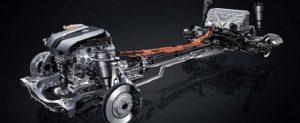
A significant uptick, made even more significant given the uptick in power.
That’s the idea behind replacing displacement with boost. A smaller engine uses less gas than a bigger one. At least, when the smaller engine isn’t under boost, in order to get it to make the power of a larger-displacement engine. The turbo also acts as a torque-enhancer, which is why this comparatively small V6 makes much more torque than most V8s. That ought to help the Tundra pull heavy loads with less effort.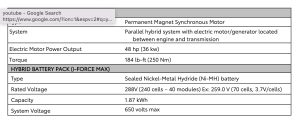
However, it will be under pressure.
In addition to its twin turbos, there are also twin intercoolers feeding twin air boxes, each with its own air filter (on the left and right hand side of the engine bay). The boost runs up to about 20 psi, which may have an impact on the longevity of this engine – but we won’t be able to judge that until at least ten years have gone by.
Toyota also offers a stronger version of the V6 in CrewMax Tundras, Limited trims and up. This one has the previously mentioned mild-hybrid assist which – interestingly – does not result in a higher EPA mileage rating. However, it’s not much lower – 19 city, 22 highway – which is about the same, overall. But you get much more power (437 horsepower) and diesel-like 583 ft.-lbs. of torque. 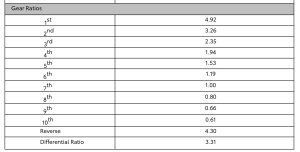
Both versions of the V6 are paired with a ten -speed automatic transmission that features three overdrive ratios (8th, 9th and 10th) with the final OD radio being a really deep 0.61 ratio that reduces engine speed at highway speeds to little more than a fast idle.
The available 4WD system is electrically engaged, with settings for 2WD and 4WD high as well as 4WD Low (with a 2.640 ratio in 4WD Low).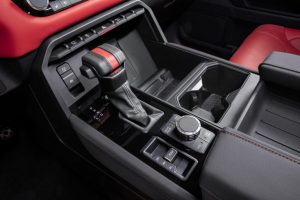
Tow ratings range from 8,300-12,000 lbs. depending on configuration.
Even with its standard V8, the current Nissan Titan is only rated to tow about 9,300 lbs.
On the Road
It sounds like it has a V8 . . . at least, it does – if you drive a Tundra equipped with the sound of a V8.
Literally.
Higher trims – Limited and up – come with sound augmentation technology that pipes the sound of last year’s V8 through the JBL sound system of this year’s Tundra. I was surprised when I first heard it, because I knew about the V6 (and know what a V8 sounds like). But when I floored the accelerator, a low bass moan could be heard – and you could not tell it came from the sound system.
It feels like a V8, at any rate.
In fact, the V6-powered Tundra is quicker than the previous V8 Tundra, doing the 0-60 run in about 6.4 seconds vs. 6.7 previously. This does much to tamp down any sounds – of disappointment – that the V8 has been replaced. If the new Tundra were slower . . . if it had less power . . . then piping the sound of its healthier predecessor through the speakers would have been as pathetic as flexing fake muscles or stuffing a sock in your crotch, so as to show off what you’re not packing.
From a purely driving perspective, it is hard to fault the new V6. If you didn’t know it was a V6 you’d likely never guess it wasn’t a V8. The pull – and the sound – match expectations. It is torquey – and throaty. The only indication there’s not a V8 under there is the turbo boost bar in the main gauge cluster, which lets you know that it’s boost rather than displacement that’s responsible for the response.
Adding the sound was likely deemed essential to replicate the experience, which is as much psychological as it is numerical. You can quote horsepower and torque numbers all day long and while they are certainly important, they are not everything.
Not if that one important thing is missing.
I wasn’t able to test drive a model without the sound of the V8; if those lacking the augmentation sound like there’s a V6 under the hood, Toyota ought to make the sound of something more standard in all Tundras so as to help people forget the V8’s no longer there.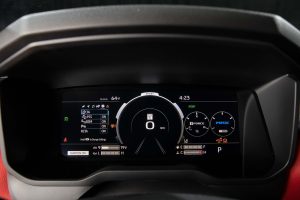
The gas mileage situation is another matter. Though EPA says the V6 Tundra averages about 20 MPG – as opposed to about 15 for the previous V8 Tundra – I averaged . . . just over 15 MPG. This is par for the turbocharged course, in my experience – and I have experienced dozens (scores) of new vehicles of all types with smaller, turbocharged engines in lieu of larger displacement and supposedly “less efficient” engines.
Smaller-displacement turbo’d engines score better on the EPA tests that determine the rated mileage figures. In the real world, they generally score worse (or rather, not appreciably better) because in order to replicate the power (and deliver the performance) of the bigger engine they’ve replaced, they must be boosted to produce it. It’s a Catch 22 situation in that you’ll probably only see the EPA’s mileage numbers if you don’t summon the power (via the boost) in which case you have power you can’t really use much – assuming you want to see those EPA numbers rather than the real world numbers.
On the upside, you do get a stronger engine – and Toyota is able to sell it to you.
The government has made it extremely hard for Toyota or anyone else to sell V8s at all – which is why all of the other half-tons except the Titan come standard with sixes (the F-150’s strongest engine is a six, too; the V8 is a kind of consolation prize for those who still prize its presence).
The downside, of course, is that this V6 – with two turbos, two intercoolers and lots of other parts – is a much more complicated engine than the V8 it replaced as well as an engine that is under more pressure to deliver the power and capability of a V8 with two fewer cylinders and about 60 percent the displacement.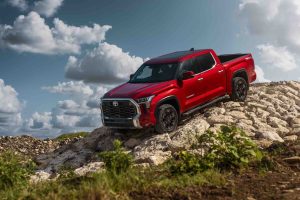
Toyota is known for solid engineering, though. The V6 may be overhead cam, but it has a steel timing chain rather than a belt. The block and heads are designed to keep their cool (important with aluminum blocks and heads) with two layers water jackets and cross-channels to maximize heat transfer to the coolant.
So, fingers crossed . . .
Tundras with the hybrid set up can roll along on electricity up to about 18 MPH, when the system automatically re-ignites the V6. These transmissions are seamless. Once again, you’d never know unless you looked under the hood.
The other thing about the Tundra is something it has in common with all of the other half-tons it competes with. That being it is huge – and specifically, wide – but so easy to drive a ten-year-old could do it.
Assuming he could reach the pedals and see over the dashboard at the same time. Driving the Tundra is like piloting a battleship that can maneuver like a PT boat that also rides like the Queen Mary. It takes up almost every inch of a narrow backcountry road – but it takes to the road almost like a sports car.
Just be on the alert if there’s another behemoth coming at you from the opposite direction – as the two of you might smack mirrors if you’re not careful.
Behemoth is just the right word.
The shortest version of the Tundra – DoubleCab with the 6.5 foot bed – is 233.6 inches long, bumper-to-bumper. The longest version – Double Cab with the 8.1 foot bed – is 252.5 inches long. That’s about two feet longer than one of the the longest American cars ever made – the Buick Electra 225 of the ’70s.
But it’s the width of this thing – of all these things – that is most behemothian. A bit more than 80 inches – not counting the mirrors. How wide is that? It is three inches wider than a Mercedes S-Class, which is just about the widest car still available.
And wide is good – insofar as room. There is so much of it you may feel you’re not making enough use of it – like the extra 1,500 square feet in a huge house you almost never use. But if you need the room, it’s nice to have it. The CrewMax has enough room to seat four in a row – even if there are only seatbelts for three. There is actually more legroom in the back (41.6 inches) than there is up front (41.2 inches).
But wide is not-so-good when the roads (and parking spots) aren’t. All of the current 1500s are dimensionally very close to the dimensions of yesterday’s 2500s. Keep that in mind as you maneuver.
As big as it is, the Tundra’s looks are less forbidding than some of the others in the class, which seem to have been designed to look as forbidding as possible. It has an almost car-like windshield rake, which gives the appearance of a lower roofline. The bedwalls aren’t as over-the-top high, either. You don’t need to stand on a milk crate to be able to reach whatever you put in the bed.
It’s a more accessible and usable truck for that reason.
It is also a lighter and more dent-resistant bed, being made not of steel or aluminum but rather Sheet Molded Composite, reinforced with aluminum.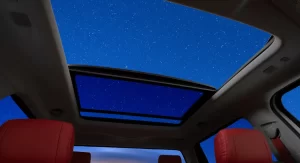
Inside, the big continues – with an available 14 inch LCD touchscreen that features sensitivity adjustment to make it easier to operate while wearing gloves. This will appeal to those who want the latest tech – while the continued presence of knobs and toggle buttons for most essential functions will appeal to those not enamored as much of “tech.”
The Rest
The Tundra has a unique take on the automatic stop-start (ASS) system that afflicts practically all new vehicles. You can turn it on – or off – by depressing the brake pedal harder (or less) when the vehicle is not moving. It is a much more fluid – and far less annoying – way to keep ASS under control.
The doors also have keyed locks – in addition to keyless entry. Meaning you can use a physical key to unlock your Tundra if you lose your fob (or get it wet and it no longer works). You can also lower the tailgate using your remote key fob.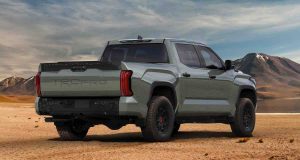
The truck’s main detraction – if it is one – is that you cannot get a regular cab and you cannot get the 8.1 foot long bed with the CrewMax cab. The Big Three trucks are more configurable.
The Bottom Line
The absence of a V8 is what may keep the Tundra in this game.
Or, not.
Got a question about cars, Libertarian politics – or anything else? Click on the “ask Eric” link and send ’em in! Or email me at [email protected] if the @!** “ask Eric” button doesn’t work!
If you like what you’ve found here please consider supporting EPautos.
We depend on you to keep the wheels turning!
Our donate button is here.
If you prefer not to use PayPal, our mailing address is:
EPautos
721 Hummingbird Lane SE
Copper Hill, VA 24079
PS: Get an EPautos magnet or sticker or coaster in return for a $20 or more one-time donation or a $10 or more monthly recurring donation. (Please be sure to tell us you want a magnet or sticker or coaster – and also, provide an address, so we know where to mail the thing!)
My eBook about car buying (new and used) is also available for your favorite price – free! Click here. If that fails, email me at [email protected] and I will send you a copy directly!


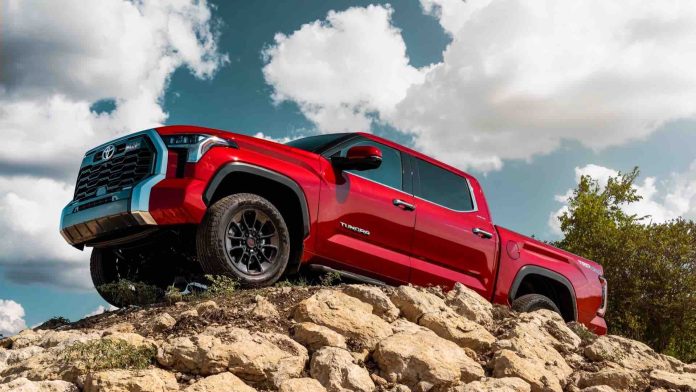


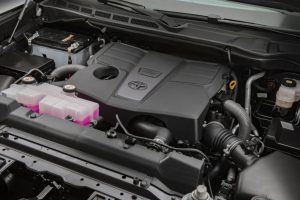

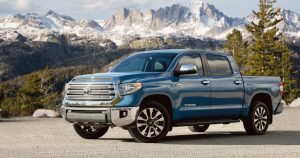








Have been a long time Tundra driver – purchased a 2013 Platinum in 2015. Dearly loved the truck and averaged 35-40k miles every year. Daily driver for work – it served as mobile office and work truck. Completely and utterly reliable and averaged around 15mpg.
That being said – given the market conditions and mileage that had built up on the 2013, I traded for a 2022 Tundra Platinum and have been nothing but impressed with the new vehicle. My gas mileage averages around 19mpg, it rides noticeably better than the 2013 and pulls a trailer at highway speeds far better than the 2013. In short – it just works and does everything as well as and better than the 2013.
There has been some discussion (good and bad) of the use of a V6 – but the same engine has been used for time in the larger Lexus sedans with exceptional results and reliability. Am pretty confident that Toyota made the right decision on this platform.
Hi BDub,
I agree; Toyota is typically very conscientious about engineering. But I have concerns about such a small engine in such a big (and heavy) vehicle, especially one expected to do real work. Maybe these turbo V6 engines will prove to be as durable and reliable over the long haul as the V8s they’re supplanting. But only time will tell…
The best part of the review is
and “he’s wearing a freaking diaper.All alone in his car and the thing is wearing a diaper”
Thank you, made my day!
My pleasure, Robert!
I loooovvvvvvveeee the newer larger 1500’s. Yeah, they are wider too, but it’s not a problem in rural usa. Makes me feel like I’m back in the 70’s boats. and mine rides like one, but actually handles way better. Have it filled with 5 people all the time, loaded with 2-3 dirtbikes, tow big, drive fast on dirt roads like a king. Got the great 5.7, which is probably the last. Time will tell how the new 6TT does (for me). I am more vehicle happy than I’ve been in 20+ years.
Last favorite was probably the Park Ave blown, but it couldn’t carry dirtbikes or tow or do dirt roads well, but it was a great sedan.
The Crew Tundra w/8ft bed has me intrigued.
Hi Chris,
I amen all you say except for the bed walls and ride height. I love my ’02 Nissan because it is so easy to toss stuff in the bed and get it out again. This used to be true of all stock pick-ups, including 1500s. Now they’ve all got these silly suer-tall bedwalls that almost require a step ladder to get in the bed. And the jacked-up ride height makes no sense unless you need to go seriously off-road. I garage keep my ’02 Nissan because I want it to last forever!
Certainly your choice Eric, and I respect that. So far, we still have those choices, we’ll see what the future brings, not holding my breath.
I said somewhere else on your site why I think they’ve gotten so high, basically them trying to outdo each other, over time.
For sure, the flat floor (on mine) is a reason for height, don’t know why they did that unless ‘focus’ groups’ said they wanted it.
But again, it is a minor inconvenience compared to all the other awesome pluses these rigs are now (for me).
2022 Tundra hybrid ice curb weight 6184 lb. V6 437 hp fuel economy combined 24 mpg
2022 Tundra gas ice curb weight 5798 lb. V6 389 hp fuel economy combined 23 mpg
2000 Tundra gas ice curb weight 3935 lb. V8 245 hp fuel economy combined 23 mpg
2000 Tundra gas ice TRD introduced a second supercharger for the V8 (2000-2003 models) engine late into its second year of production that increased to the mid 300 hp The power to weight ratio for that truck was 11 lb per hp.
The power to weight ratio for the 2022 gas Tundra and the 2022 hybrid Tundra are almost the same about 14 lb per hp. the 2000 Tundra has 16 lb per hp. but has a nice V8 and sounds better.
In 22 years the Tundra got 57% heavier.
The average EV gets 20.8 mpg, the Hummer EV gets 10 mpg. progress…haha
News flash: Toyota buying back electric suv it can not fix.
https://www.msn.com/en-us/lifestyle/shopping/toyota-offers-to-buy-back-its-recalled-bz4x-electric-suvs/ar-AA10nScb
This is such a crazy fail for any business selling any product. Yet, it’s kept on the DL by the MSM narrative pushers. Crickets.
Conform to the ESG agenda and get cash or ignore it and get penalized, sanctioned, so Toyota replaces the V8 with a V6….thanks to the globalist/leftists….
What Is ESG? (Environmental, Social and Corporate Governance) It’s A Leveraging Tool For The Woke Communist Takeover
The term “ESG” was originally coined by the United Nations Environment Program Initiative in 2005, but the methodology was not fully applied to the corporate world until the past six years when ESG investment skyrocketed.
Corporations are at bottom creations of government; they are chartered by governments, receive special legal advantages including corporate personhood, and they often receive special protections from governments including central bank stimulus and a shield from civil litigation. They call it “too big to fail” because the government and the corporate world work hand in hand to keep certain institutions alive.
One could call this an odd mix of communism and fascism; the point is, the lines have blurred beyond all recognition and the ideology of the people in power is specifically leftist/communist/globalist. Corporations already have government incentives to protect the corrupt status quo, but ESG is designed to lure them into supporting vocal political alignment even at the cost of normal profits.
ESG is about money; loans given out by top banks and foundations to companies that meet the guidelines of “stakeholder capitalism.” Companies must show that they are actively pursuing a business environment that prioritizes woke virtues and climate change restrictions.
These loans are not an all prevailing income source, but ESG loans are highly targeted, they are growing in size (for now) and they are very easy to get as long as a company is willing to preach the social justice gospel as loudly as possible.
These loans become a form of leverage over the business world – Once they get a taste of that easy money they keep coming back. Many of the loan targets attached to ESG are rarely enforced and penalties are few and far between. Primarily, an ESG funded company must propagandize, that is all. They must propagandize their employees and they must propagandize their customers. As long as they do this, that sweet loan capital keeps flowing.
The list of companies heavily involved in ESG includes some of the largest in the world, with influence over thousands of smaller businesses. The ESG rating system is much like the social credit scoring system used in communist China to oppress the citizenry.
The tactic is pretty straightforward – Banking elites are centralizing control of social narratives by incentivising businesses to embrace social justice and globalist ideals, like climate change. They control who gets the money and anyone who doesn’t play ball will be at a distinct disadvantage compared to companies that do.
Businesses not cooperating get starved/pushed out, demonized.
https://www.zerohedge.com/political/what-esg-its-leveraging-tool-woke-communist-takeover
100 top ESG money hand out grabbers (businesses), with their face deepest in the trough, getting cash for pushing the ESG, climate change, EV lies 24/7…..
boycott these bastards….lol
https://www.investors.com/news/esg-companies-list-best-esg-stocks-environmental-social-governance-values/
Yeah, the Tundra is So Huge. Really hard to drive and park in anything but a Jumbo sized road or lot. Hard to live with as your primary vehicle in even a suburban environment. In the mid 1990s, smaller half tons seemed to be much more prevalent. They could serve not only as a work tool, but also a lifestyle statement, in some cases a sports car, and in most cases, a primary car.
Did 1500s get bigger just because the builders embraced a “mine is bigger than yours” competition? I think that MPG mandates also played a part. They had to get many truck drivers into smaller, more economical stuff, like SUV/CUVs.
Tacomas of course, are a lot closer to “just right” size. Let’s hope Toyota can soon bring out a totally new Taco, while resisting the urge to make it any bigger than it is now.
I was very interested to read your review of the new Tundra, because I really like the way the new ones look, but I’m not a fan of forced induction because of the durability issues.
Turbo motors and the EPA mpg test are like the teacher that teaches you the exam and you ace it, but in the real world do you know what you need to do a job? I had a Sonata 2.0T and it did great on the highway (34mpg or better sometimes), but lousy in the city and was later the subject of a recall because the engine blew itself to bits and required a replacement.
When the pandemic hit and I was stuck “working” from home, I needed something to get my mind off things. I bought a 2010 Tundra crew max 4WD from an old man with about 200k on the odometer or so. It was largely immaculate (I did buff out the paint and deep-clean the interior before putting in Weathertech floor mats and it became a canvas for me. I put in a suspension lift and some Fox shocks, put some beadlock rims and off-road tires and installed some brush guards and a massive Warn winch on the new front bumper. I also installed some skid plates, a Borla exhaust that makes the iForce V-8 really rumble and a bigger stainless steel radiator.
So for about $20k and a whole lot of elbow grease, I built an off-road truck that laughs at the TRD Pros sold at the dealership and saved $30K in the process. I’ve put about 50k miles on it since and it’s been stone-cold reliable. You can’t replace that tasty V-8 rumble. After my experience with the boosted Hyundai, I don’t think I’d trust even a Toyota truck with a boosted motor.
I wouldn’t trade this truck for any reason and intend to hand it down to one of my sons when I’m gone. I also bought a first-generation Sequoia before used car prices went insane and I’ve gotten it into fine running shape for my middle son, who drives it to school every day and loves it. I feel a great swell of pride when I see him changing the oil in our garage and washing it in the driveway.
Hi Dr. –
Same here. Unless you just have to have “new,” it makes little sense to buy it. I could completely go through my ’02 Frontier for about $15k ($20k if I wanted a like-new paint job) and have – effectively – a new truck for less than the cost of any new truck by many thousands of dollars. One free of the peremptory parenting “technology” and other stuff (such as LCD screens) I have no interest in.
The old Tundra was a stout rig that – like the 4Runner and GX460 – were (and are) loved by those who have them because they will go 20-plus years and 300,000 miles if you don’t deliberately abuse them.
I hope this new Tundra lives up to that standard…
Eric, the fuel mileage you experienced is very typical of V6 turbo engines.
My friend has an Eco Boost Ford F150.
He told me you can have Eco or Boost, but not both.
Hi npd,
“He told me you can have Eco or Boost, but not both.”
That’s the quip of the day!
“The Big Three trucks are more configurable” I don’t think Ram or Chevy offers anything in half ton with an 8′ bed. The 8′.1″ bed offering from Toyota is why it would be on my list for consideration.
Hi Spit,
That’s true, although Ram does offer two engine options – so there’s that. But I agree with you about the no-regular-cab/eight-foot-bed combo. That seems to be a function of many buyers of 1500s using them for people-carrying primarily rather than just work.
Eric,
“many buyers of 1500s using them for people-carrying primarily rather than just work.”
The age of the goat roper continues. Once upon a time, when people viewed trucks as tools instead of ego building appliances, they were cheaper than cars. Quite a bit cheaper.
The size of modern trucks astonishes me. In 1989 I bought a new Dodge Dakota 4WD precisely because the bed height was the same as 2WD. Now all the 2WD are just as high as the 4WD. I’ve got a ’97 Tacoma, and a few years ago, I was astonished at the size of the current Tacoma. Hard to tell them from full size. In fact, I’ve had full size pickups that were no bigger. Bigger is not better, unless you are trying to compensate for the size of other things. I dare any late model Tacoma to go where I can go in my ’97 off road.
‘I averaged . . . just over 15 MPG.’ — eric
About the same as the half-ton pickups of 20 years ago. Unimpressive.
But then, the Tundra is a 5,000-plus pound behemoth. That’s a lotta lard-ass to push around.
Tundra has copied the Chevy Silverado’s “blockhead” look, with the hood elevated to an absurd 4 feet off the ground, fronted by a giant ugly grille the size of a bedsheet.
To my eye, this is a scaled-up child’s toy truck, straight out of the pages of a superhero comic book.
Ain’t drivin’ no flat-nosed cartoon of a truck.
Jim H,
15 MPG 20 years ago? Try 40 or 50. I’m 68 years old, and used trucks as a tool for the first 26 years of my working life. I don’t recall any getting significantly less than 15 MPG. 6 cylinder or V8. And that usually included a few hundred pounds of payload.
Hi John,
How bad is it – in terms of “mileage”? My ’76 Trans-Am, with a massive 7.5 liter (455 cubic inch) carbureted V8 gets about the same mileage as the new Tundra.
John,
When I was looking at a Ford F-150 from the early 2000s, this table of mileage for various models and engines quickly dented my enthusiasm:
https://www.fueleconomy.gov/feg/bymodel/2003_Ford_F150_Pickup.shtml
One of the 5.4L V8s is rated at 15 combined city/highway; another one at 13 combined.
I don’t know what you were driving but I haven’t seen a pickup from the 80’s or 90’s that got better than about 14 mpg’s in optimal conditions. That was regular cab pickups.
Newer ones aren’t much better, but they have significantly more power and capability than the old ones.
I had a 2008 Tundra with the 5.7 v8–currently have a 2016–that would blow the doors off of my 1998 Silverado with a 5.7 v8. My silverado only got slightly better gas mileage and it was lighter.
The sad thing is that v-8’s are going away and this new Tundra won’t have the longevity or quality of the last generation of v8’s. But, the comparison is to the big 3’s turbo sixes. All Toyota has to do is be better than an eco-boost shit box that Ford sells. That’s all but guaranteed.
Toyota aught to keep the v-8, add a diesel and get into the HD pickup market. That’s where dependability and longevity shine. The 1500 market impresses people with gimmicks and EPA fuel ratings.